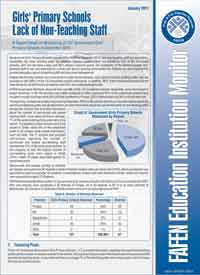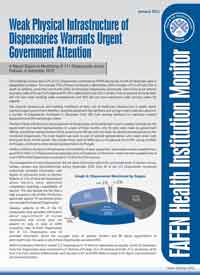A Report based on Monitoring of 137 Government Girls’ Primary Schools in December 2010
ISLAMABAD: Government Girls’ Primary Schools lack non-teaching staff and arrangement of clean drinking water for students, according to FAFEN Education Monitor, based on the monitoring of 137 Girls Primary Schools in 87 districts of four provinces and FATA.
As many as 59 schools were monitored in 32 districts of Punjab, 33 in 23 districts of KP, 8 in as many districts of Balochistan, 35 schools in 22 districts of Sindh and 2 schools in as many agencies of FATA.
Sanitary workers were not present in 72% of the monitored schools, 32% did not have a peon and 29% lacked a security guard. Despite the fact that children are more prone to water-borne diseases, basic facility of clean drinking water was not available to half (49%) of the 137 monitored schools nationwide. In addition, 46% of the monitored schools did not have the facility of staff rooms for teachers and 24% were without playgrounds.
FAFEN Governance Monitors observed that one-fifth of the 137 monitored schools were not housed in proper buildings. The situation was better in KP in this regard as compared to all the other regions.
Transparency surfaced as a major issue during December 2010 as 20 schools did not provide information about the sanctioned teaching posts and 66 declined to provide information about the sanctioned posts of non-teaching staff. Information regarding the attendance of teachers and students in the school, on the day of FAFEN observer’s visit, was also withheld by some schools.
Seven percent of the total sanctioned teaching posts and 13% of the sanctioned non-teaching posts in the monitored schools were lying vacant. The highest number of unoccupied teaching (9%) and non-teaching (22%) posts were observed in Sindh.
Nationwide, the average number of students per teacher came out to be 34. The highest number of student per teacher ratio was observed in FATA, where one teacher was appointed to teach on average, 45 students and the lowest student per teacher ratio was observed in Sindh, where one teacher was responsible to teach 27 students.
Despite 82 oversight visits by the government and elected officials to monitored schools in past three months (September, October, and November), issues of physical infrastructure, vacant teaching and non teaching posts were observed in the 137 monitored facilities.
To download complete report, click here



